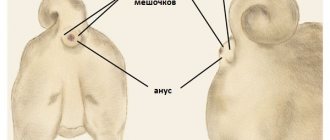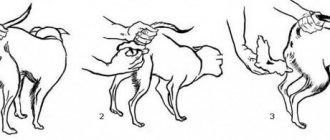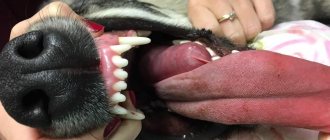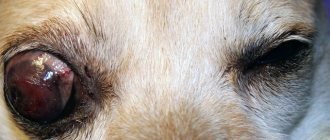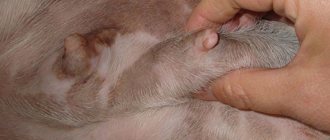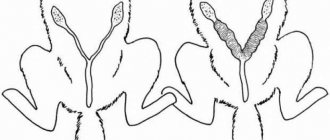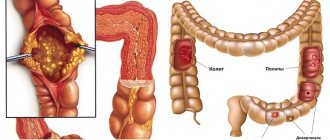Not all dog owners know that their pets have paraanal glands, since they often do not cause any problems and live “their” lives. These glands are located on the sides of the dog's anus and have ducts into the rectum where it passes into the anus. Inflammation of the paraanal glands in dogs uncomfortable for the pet. The secretion of the anal glands has a liquid consistency and light brown color, as well as a specific pungent odor, which helps dogs mark their territory and arouse interest among individuals of the opposite sex. As a rule, the glands clear themselves of secretions during the act of defecation, as well as during active games, stress or walking.
Pets often have problems with independent secretion, and then, as a consequence, inflammation of the paraanal glands occurs in dogs. It causes pain and discomfort to the animal
, and in advanced cases it threatens the appearance of an abscess in a delicate place. And this is a direct threat of sepsis and fistula formation, which is fraught with the most tragic consequences for the pet’s life. Therefore, dog owners need to know the symptoms of the disease, its causes and preventive measures in order to help their dog in time.
Inflammation of the paraanal glands in dogs. Causes of blockage
In nature, everything that is not used degrades. In modern dogs, the glands can no longer function at the same level as in their wild relatives, which is why fluid stagnation occurs, causing a chain reaction
further development of the pathology.
- Experts call the following factors predisposing to inflammation of the anal glands in dogs:
- sedentary lifestyle;
- excess weight in dogs puts them at risk, so it is advisable for them to clean their glands for preventive purposes;
- the influence of hereditary predisposition - most often the disease occurs in representatives of small and decorative breeds: Pekingese, dachshund, pug, bulldog;
- low immunity - pets have a weaker immune system than their street relatives;
- anal injuries and their infection with pathogenic microflora;
- dietary errors, for example, giving bones and other roughage;
- pregnancy;
- frequent matings;
- a large amount of protein foods;
- insufficient control over the condition of the paraanal glands by the owner.
How does inflammation of the paraanal glands develop in dogs?
The anal glands look like small sacs located in the anus area like the numbers 4 and 8 on a watch dial. They constantly, like all glands, produce their secretion. If they overflow
, then they increase in size, become inflamed, and the outflow of fluid does not occur.
- We can highlight the following stages in the development of inflammation of the paraanal glands
- normal outflow of fluid from the glands does not occur;
- they overflow and swell;
- the secretion in the glands thickens;
- the cavity of the gland becomes inflamed and the animal feels pain and itching in the anal area;
- pathogenic microbes multiply in the inflamed area;
- this leads to worsening inflammation, the development of a purulent process and an abscess;
- if the abscess is not treated surgically, it ruptures on its own, forming a through hole between the gland and other organs;
- the temperature will rise and sepsis will develop.
:
Of course, it will take time before an abscess occurs, and an attentive owner will not let the disease take its course, which could result in the death of the pet. The glands operated on as a result of an abscess often become inflamed and fester again, in which case surgery to remove them may be required.
General description of the glands
In dogs, like all other animals, there are special glands on the sides of the anus, which are called paraanal glands. They are small bags in which a secretion accumulates, which has a pungent odor and a light brown color. With its help, dogs mark their territory, scaring away enemies. In their structure, the pouches resemble sebaceous or sweat glands.
If the pet lives in an apartment, there is no need for these bags to work, which leads to stagnation of fluid. This condition after some time leads to the development of an inflammatory process.
Inflammation of the paraanal glands in dogs: symptoms
For the most part, changes in the dog's behavior indicate that there is a problem:
- she is restless, does not allow her hips and tail to be touched;
- experiences pain and discomfort in a sitting position and during bowel movements;
- licks and bites the anus area, as the absorbed secretion provokes severe itching;
- refuses food;
- “rides” on the butt, which owners may mistakenly take as a symptom of helminthic infestation;
- wags his tail, grabs his own tail.
Examining the anal area, you can see redness and swelling of the anus, scratching, rash, baldness of the area under the tail
. If an abscess occurs, it will appear as a large lump on the side of the anus.
Causes of inflammation
Animals living on the street practically do not suffer from this problem, but pets, for various reasons, often cause their owners concern about this.
There are several reasons that can provoke this disease:
1. Hereditary factor. Most often, such a genetic predisposition occurs in small dogs, for example, pugs and bulldogs. And if the animal is also overweight, then this aggravates the situation.
2. Wrong diet. Often, owners pamper their pets with food from their table. It must be taken into account that excessive amounts of fatty, salty or sweet foods can lead to blockage of the anal glands.
3. Low physical activity. This is especially true for domestic dogs, which are forced to sit in the apartment all day waiting for their owner.
4. Reduced immunity. This is also the prerogative of domestic animals, unlike their wild relatives.
5. Inattentive owners. Often the inflammatory process begins due to the carelessness of the owner, who did not notice the blockage of the anal glands in time.
Treatment for inflammation of the paraanal glands in a dog
Early contact with a veterinarian will help you avoid serious complications and long-term treatment.
when the glands are just clogged.
The doctor will perform mechanical cleaning and give you recommendations for further monitoring and care of them. If the inflammation has already developed severely
, then more serious measures will be required: cleaning the clogged glands using local anesthetics, washing the inflamed sinuses, a course of antibiotics if a bacterial infection is attached, prescribing rectal suppositories with an anti-inflammatory effect.
If there is an abscess
the doctor can puncture it, wash it with disinfectants, install drainage for fluid outflow, set up novocaine blockades, and antibiotic therapy.
In some cases, when persistent inflammation and suppuration of the paraanal glands occurs, the doctor will recommend their surgical removal. The operation is simple and does not in any way injure the rectum or anal sphincter, so within a day after the intervention the dog goes to the toilet normally and behaves as usual. A light diet and frequent walks are recommended so that the pet can defecate in a timely manner.
What causes blockage of the anal glands?
Blockage of the paraanal glands occurs because the secretion accumulates in the glands for a long time and does not come out. Problems with the anal glands are a direct consequence of problems with excretion of feces from the animal’s body.
These problems may be caused by:
- Sedentary lifestyle (the animal moves so little that problems arise not only with excretion, but also with the formation of feces).
- Poor nutrition (frequent constipation or diarrhea leads to the fact that when passing through the anus, feces have such a heterogeneous consistency that they simply do not squeeze out the secretion from the paraanal glands).
- Incorrect daily routine (the animal endures a lot and, as a result, secretions accumulate in the glands and blockage occurs).
Preventive measures - inflammation of the paraanal glands in dogs
To prevent the development of inflammation of the dog's anal sacs , you need to carefully monitor your pet's behavior, and if symptoms of secretion stagnation in the glands occur, you can clean them yourself.
- Algorithm for cleaning the anal glands in dogs:
- Since the procedure will be “dirty”, it is better to put the dog in the bath. There is enough space for a small dog in the basin.
- Bring a helper with you to hold the dog by the front of the body.
- Grab the tail and lift it up.
- Put on rubber gloves and feel the glands on the sides of the anus.
- Gently massage the area on both sides of the anus, squeezing it evenly with your free hand, this releases a liquid or thick secretion with a pungent odor. You can also use a napkin during these manipulations until the liquid stops coming out.
- Remember the rules that will help avoid stagnation of fluid in the paraanal sinuses:
- Walk your dog enough time to ensure that all its muscles are in good tone.
- Carry out regular monitoring of the anal area. There is no need to clean healthy glands so as not to injure them.
- Make sure your dog does not gain excess weight.
- Carry out planned anthelmintic measures.
- The dog's stool should be regular.
- Your dog's diet should contain fiber.
Owners with little experience in keeping dogs naturally have many questions on this topic. You can get answers to your questions by calling our veterinarian at I-VET. Doctor's consultation is free.
You can also call a veterinary specialist to your home so that he can examine your pet in a calm home environment, if necessary, carry out a cleaning procedure, and give recommendations for further care. The doctor will arrive at a time that suits you and will subsequently be in touch with you to monitor your pet’s well-being. Call us, we are working to ensure that our four-legged patients recover as quickly as possible!
Reasons why a dog licks its owner
When a dog licks not only the owner’s nose, forehead and chin, but also his hearing organs, this behavior indicates attempts to express his affection, respect, or collect the necessary information. The pet checks the well-being and emotional state of a person through its receptors.
Dog licks face
What does it mean when a dog licks a person's face?
If an animal is engaged in “laundering” only a certain part, then with such behavior it expresses:
- taste. The secretion secreted by the sweat glands has a salty taste. Some pets like it, while others try in this way to compensate for the lack of microelements necessary for the body;
- hunger. Licking is used to draw attention to an issue. At a young age, puppies communicate in this way to their mother that they need to be fed. Sometimes dogs use begging techniques, especially when the owner eats something attractive and forbidden to the pet;
- attachment. The pet loves to be close to its owner. If we take an analogy, then in the nest the puppies receive affection not only from their mother, but also from their brothers. This method is used to strengthen family ties. By licking the forehead, chin and ears, the dog not only expresses his affection, but also shows that the person is a member of his pack;
- collection of information. To find out about a person’s well-being, all a pet needs to do is lick him. Special receptors help to find out about this when studying substances licked from human skin. A couple of tongue movements are enough for the dog to know about a good or bad mood, or a secretly developing disease;
- respect. In the wild, animals obey a certain social order. Life in a pack involves “washing” the leader’s muzzle to express submission and respect. When communicating with a person, dogs show that they recognize the alpha male in a person;
- pleasure. The process of licking leads to the active production of endorphins. These substances create the effect of comfort and complete safety. Otherwise, the procedure is associated with the pleasure that the pet receives;
- care. This method is used to maintain hygiene instead of taking a bath or shower. For an animal, the owner is no different from his brothers; he is trying to help him become clean. Washing may be associated with a strong smell of cologne or aftershave cream.
Important! Some animals get carried away with “washing” their owner’s face, and this approach to hygiene or expression of emotions begins to cause irritation. When a pet appears in the house, it is necessary to initially determine the boundaries of acceptable behavior so that misunderstandings do not arise.
A dog who spends his entire childhood “washing” a person will not understand if one day he receives a strict ban on his usual actions.
Why does a dog lick a person's feet?
There are several underlying reasons why a pet develops such a reflex:
smell Under natural conditions it attracts the attention of potential enemies
If a dog has thoroughly licked its feet and toes, then it is trying to protect its owner and itself from attacks by aggressive and dangerous predators. Any unnatural odors are regarded as a threat to the entire pack and it does not matter what their source is: fragrant soap or the pungent aroma of sweat; dogs lick reflexively at the sight of a bowl filled with food. The salivary glands are activated by any changes: internal or external
Too regular and unreasonable action can be a sign of a serious disease that is gradually developing in the pet’s body;
Dog licks feet
- wounds. The four-legged animals disinfect any superficial or deep damage to the skin with their own saliva. A similar approach is used when detecting cracks and abrasions on the legs of a beloved owner;
- salt. If the animal’s diet does not have enough chlorine and sodium, which are used for the normal functioning of the stomach, then the volume of hydrochloric acid production decreases. Its lack provokes disturbances in the digestive processes and deterioration of appetite. When draining sweat, the pet replenishes the deficiency of substances;
- fear. Timid and timid touches indicate problems that exist in the relationship between the animal and its owner. In case of aggressive behavior towards a pet, regular and unreasonable punishment, a person needs to adjust his own behavior.
Note! In the absence of visible signs of damage, the pet may begin to show interest in a certain part: legs, arms, armpits. Unlike his owner, he “sees” the beginning of the inflammatory process, anticipates attacks of gout or arthritis and tries to relieve him of the approaching painful sensations
Inflammatory process
If you do not clean the anal glands, the secretion begins to accumulate, becomes thick, and bacteria actively multiply in it. This is how the inflammatory process begins; just by the behavior of the animal one can suspect its presence:
- The dog is constantly chewing under his tail.
- Often rubs his anus on the floor or furniture.
- The anus becomes swollen and red.
- The fur around the glands begins to fade and fall out.
- The skin is noticeably irritated, rashes and scratching.
If such symptoms occur, you should immediately contact a veterinarian. When the diagnosis of “inflammation of the paraanal glands” in a dog is confirmed, the treatment will be more serious than for a normal blockage.
The doctor removes the contents of the glands, treats the skin with an antiseptic and prescribes rectal suppositories. This is more effective than external treatment and tablets, although your pet will resist such intervention.
Diagnosis of inflammation
It is usually not difficult to make a diagnosis. It is often enough for a competent specialist to examine the animal to understand the problem. To prescribe adequate treatment, it is necessary to conduct functional diagnostics and clinical studies.
During the examination, the doctor must find out the color and consistency of the secretion, and the presence of odor. If there are streaks of blood and a foul odor in the discharge, then we can say with certainty that bacteria are to blame for the inflammation of the anal glands in dogs. Treatment will have to be carried out using antibiotics.
Symptoms of the disease
When the paraanal glands in dogs just begin to become clogged, this practically does not manifest itself at all. The animal may experience some discomfort, which it tries to get rid of on its own. Moreover, most often at this stage the secretion begins to become thicker, so in the absence of a reaction from the host, the process of inflammation will only progress over time.
You should immediately visit a veterinarian if you notice the following symptoms in your pet:
- The dog grabs its tail.
- Often licks the anus.
- The pet rotates its tail.
- When you touch the rear part, the animal experiences pain.
- Pain during bowel movements.
- “Rides” on his butt.
- In some cases, body temperature rises.
A loving owner will always pay attention to his pet’s anxiety and do everything to save him from suffering. This is a fairly common problem - inflammation of the paraanal glands in dogs. Treatment is required immediately so as not to lead to serious complications and irreversible consequences.
